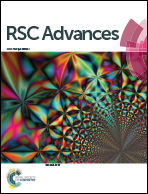Fast electrodeposition, influencing factors and catalytic properties of dendritic Cu–M (M = Ni, Fe, Co) microstructures
Abstract
The rapid electrochemical deposition of dendritic Cu–M (M = Ni, Fe, Co) microstructures with excellent catalytic activity is reported here. Simple Cu2+ and M2+ salts were employed as the initial metal sources and boric acid was used as the buffer solution. The electrodeposition process was carried out at a deposition current of 10 mA for 5 min in air at room temperature. The phase and morphology of the as-prepared products were characterized by field emission scanning electron microscopy (FESEM), powder X-ray diffraction (XRD), energy dispersive spectrometry (EDS) and transmission electron microscopy (TEM). It was found that the formation of dendritic Cu–M microstructures could be affected by some factors including the amounts of M2+ salts and boric acid, and the deposition current and time. Cu–Ni dendrites were used as a model and their performance was studied. The investigations showed that the as-deposited Cu–Ni dendrites exhibited good electrochemical responses in 0.1 M KOH solution and could be used as an electrochemical catalyst for the reduction of nitrate and the oxidation of glucose. Also, the as-deposited Cu–M dendrites exhibited excellent catalytic activities for the reduction of 4-nitrophenol (4-NP) to 4-aminophenol (4-AP) in excess NaBH4 solution.


 Please wait while we load your content...
Please wait while we load your content...